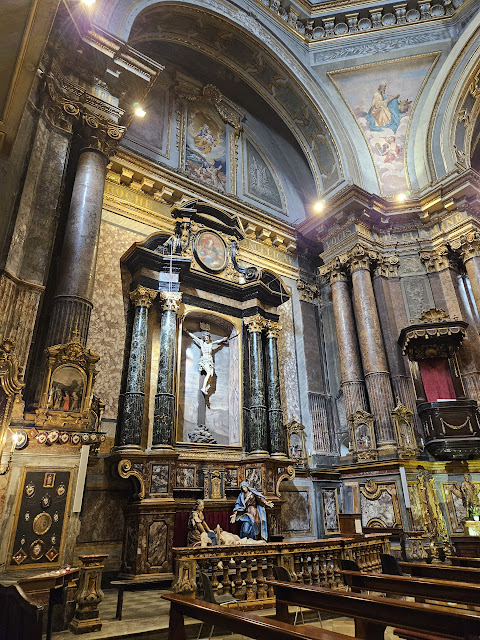This post is for all dog and animal lovers who also happen to appreciate art and architecture.
Today we are exploring the church of Saint Rocco near pedestrian Via Garibaldi, in Via San Francesco d'Assisi 1, clue number 1 about the life of this saint 😉
Like most Turin churches this is also a tiny baroque - read richly decorated - church dating back to 1663 when its construction started.
The domed vault has a large fresco where you can see the glorification of St Rocco; on the choir walls there is a large 18th century altarpiece portraying St Rocco preaching to the plague victims. Above the priest seats you can see a large baroque wood statue of St Rocco.
At each side of the entrance, there are two confessionals and two chapels whose columns look like they are made of marble but are actually made of painted wood.
 |
| unfortunately some things were stolen |
The main altar is made of polychrome marbles and alabaster from Piedmont and it holds 4 baroque golden figurines of saints and silver and gold candelabra.
The sacristy has a large hickory closet that covers the whole wall and is carved with small columns, friezes and cherubs. In the corridor you can see the 1670 laver made of marble that was used during baptisms.
All animals can feel affection but since the dawn of the times when men lived in caves, dogs have been their loyalty and honest best friend. Therefore we feel it is important to remember the miraculous story of Saint Rocco and his dog, Oreste.
Since the Middle Ages St Rocco has been known as the patron saint and protector of the dogs and of the plague victims, so it doesn't come as a surprise that during the COVID19 pandemic he's been the most worshipped Saint in the whole world!
He was raised and educated worshipping the Virgin Mary and to help those in need like soothing a crying orphan, feeding a poor hungry person and taking care of the sick. He was very devout to St Francis of Assisi and his nature and actions reminded people of him.
When he finally made it to Rome, he even healed a cardinal thus impressing the pope. After living in Rome for 3 years, he healed all those he met on his way up back towards France and his fame grew fast.
Legend has it that as he didn't have any food or water, his conditions started to decline but Oreste, a Breton dog of the landlord whose the property St Rocco was living on, in isolation, stole some bread from his owner's table daily to feed him.
Curious to see where Oreste was going with the bread in his mouth everyday, one day the landlord followed him to St Rocco's shelter.
St Rocco ended the plague pandemic in the Piacenza area and after healing all the humans, with the help of the local population, he went to the woods to heal all the animals. Then he took the way back to France but unfortunately, he was arrested and imprisoned near Voghera, by Pavia, because he refused to say who he was and the governor, his paternal uncle didn't recognize him nor believed what the people who had recognized him said.
He died alone, in prison, on August 15 or 16 between 1376 and 1379. A tablet was found by his body with these words engraved: 'whoever will call my name will be healed from the plague'.
When his grandmother, the governor's mother saw the red cross engraved on his chest, she confirmed his identity. His body was preserved in a big church and starting from Voghera and the Piacenza area people have been worshipping him.
By 1470 all of Europe worshipped St Rocco and he was especially invoked during the following pandemics. The story of St Rocco made it to the colonies on all the continents: the Americas, Madagascar, Liban and Indochina. Today he is also very popular in the Philippines, Iraq and Brazil.
After the Holy Mary, his image is the most popular one printed out in prayer cards and in statues. He is ALWAYS accompanied by Oreste, his loyal dog. In some portraits the dog has some bread in his mouth, in others he is licking the plague lesions of St Rocco to sooth them.
Email Lucia: turinepi@gmail.com
for your private walking tour in Turin with and without tastings, cooking classes and private classes.







Thanks for sharing this kind of information with us. I am so happy to read your blog. It’s so informative. Please share more and more in here with us. Thanks once again. "https://designerdogharness.com/designer-dog-collar-leash/">designer leash and collar set
ReplyDelete